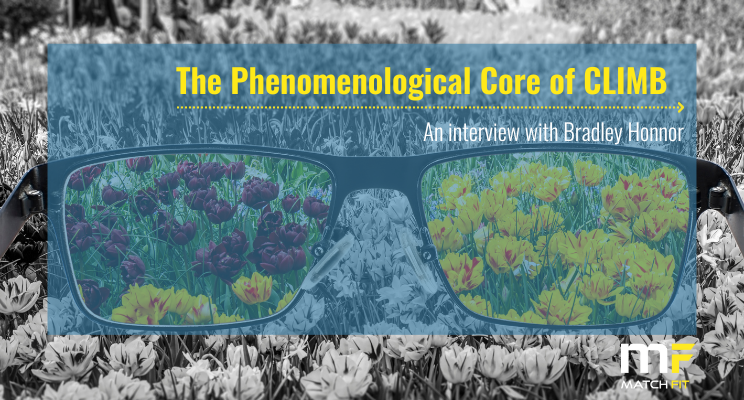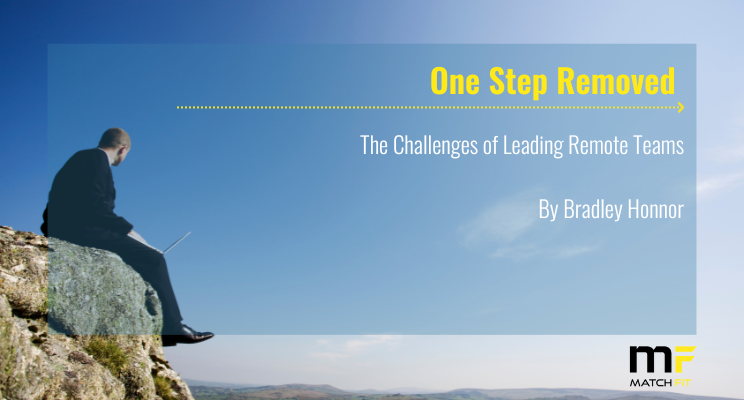The Phenomenological Core of CLIMB
An interview with Bradley Honnor
In this article, MatchFit MD Bradley Honnor talks all things ‘phenomenological’ and how this philosophy is at the very heart of MatchFit and the CLIMB people development programme.
“Phenomenology is about the individual experience that each and every one of us has,” says Bradley. “If we all go to the same party, we will all have a different experience. Everyone might say they enjoyed it, but in reality we’ve each had a different evening to the others that were with us. Everybody thinks and behaves uniquely and phenomenology is the phenomenon of that individuality. It goes beyond the collective experience.”
“In a work context, if MatchFit is delivering to a group, everyone in the group saying they enjoyed the day is not a particularly useful insight, because each person will have had a unique experience,” he continues. “We want to tap into that uniqueness, because that’s where the real value lies for an individual.”
With MatchFit’s CLIMB programme, integrating this uniqueness is inherent in everything that the team does.
“Most leadership programmes work through off-the-shelf content that may or may not fit with each individual in the session,” says Bradley. “It’s fairly typical to be sent on a training programme about delegation, for example. But if an attendee doesn’t have a team, the day becomes irrelevant, and that person won’t engage.”
Every CLIMB is very much about focusing on what each individual needs, even within a group, which is why one-to-one, as well as group work is undertaken.
“We’ll sit down with *John* to look at Mastery, which is all about *John* becoming an expert in what he does. We’ll look at what he needs, his strengths and what development areas are relevant for him specifically,” continues Bradley.
The CLIMB facilitates somebody’s personal learning journey towards their own development. This can often be in a group environment. And when the group is brought together, it’s a collective because the group will have joint goals that it needs to achieve together.
“You can speak to that group as a collective in regard to its collective goals. But each individual will have a unique input and perspective on making those goals happen in their own specific areas. That’s why the CLIMB has always taken a phenomenological approach.
When we talk about changing a culture, for example, what do we actually mean? Because the culture at work is going to be experienced differently by each individual. Some will find it fast-paced and exciting; others will find it high-pressured, oppressive and overwhelming. It’s the same culture externally, but it’s not necessarily the same culture individually. There is a phenomenological element, because of how we each interpret our particular environment in the context of how we’re experiencing it, here and now.” Bradley continues.
MatchFit consultants work with a group around their collective goals, and with individuals in terms of their individual contribution towards those goals. This explores issues such as motivation, and whether attendees actually want to do the type of activity that’s needed in order to deliver those collective goals.
“It’s not an approach that’s unfamiliar in coaching, but it differentiates MatchFit from other companies that deliver leadership programmes. Most leadership programmes provide prescribed content, which is what clients see and buy into. But we don’t have content and we don’t try to sell in that way – which does prove challenging at times!
What we actually want to do is go into a room with a team and a flip chart, pen and a blank piece of paper and ask ‘So what’s going on? What are the goals? What needs to happen to deliver those goals? What are the challenges and barriers?’
It’s a very effective methodology because everyone is identifying their own priorities, what’s important to them and what they want to engage in first. So you’ve got them on board immediately. You don’t have people sitting on the CLIMB wondering why they are there, because everybody has been able to contribute to the reason why they are there,” Bradley continues.
The CLIMB is a dynamic process with priorities often changing and evolving as the needs of the group and individuals within the group change.
“What’s important today might not be so important tomorrow,” Bradley points out. “And that’s okay. We don’t have to finish something purely because it’s been started. We can, and should, pivot very quickly according to need. That’s different to being in the middle of a standard leadership programme module, where you’ve either got to carry on, regardless of whether it’s relevant or not, or drop out and not complete it.
I often cite the example of making a presentation. You’ve prepared all your slides and know what you’re going to say. You’re halfway through your presentation and someone asks a question. In response to that question, you show them something on the flip chart that wasn’t in the presentation and may not even have been even relevant to its content. Then at the end of that day when you ask people what the most impactful part of session was, more often than not, they will say the moment when you discussed what was on the flipchart.
But on the whole, we’re just not used to operating like that. If you went on a leadership course, you’d want to see the content. You’d want to know what you’re covering on day one, when the breaks are, and how long the breaks are. Right from our school days we’ve had structure [a curriculum] and we are fed learning whether we want it or not. And adult learning is very similar.”
Bradley concludes, “This is why CLIMB has been so successful. It is different, because of that core phenomenology that’s fundamental to everything we deliver. And that is really important to MatchFit – because it’s what we know will ultimately deliver the best results for our clients.”
The Phenomenological Core of CLIMB Read More »


